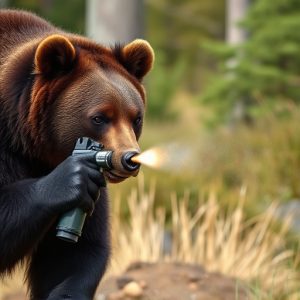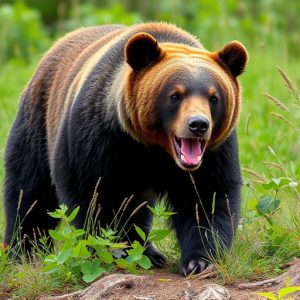Unveiling Bear Spray’s Power: Ingredients, Effects, and Safety
Bear spray, a vital tool for self-defense against bears in their natural habitat, utilizes capsaicin…….
Bear spray, a vital tool for self-defense against bears in their natural habitat, utilizes capsaicin oleoresin, a potent compound from chili peppers, as its primary active ingredient. This irritant targets bears' eyes, nose, and respiratory system, temporarily deterring them. Advanced formulations may include UV dyes and pyrethrins. Understanding the chemicals, like capsaicin, empowers users to make informed decisions for safety in bear country. While capsaicin is key, other additives enhance effectiveness and mask human odors. Proper usage involves shaking the can, aiming at the bear's face from a distance, and being mindful of wind direction to avoid self-inhalation.
“Unraveling the power behind bear spray, this article delves into the essential self-defense tool for encounters with these majestic yet potentially dangerous animals. We explore the active ingredients, particularly focusing on the key component: capsaicin oleoresin. Understanding its role and how it triggers a bear’s reaction is crucial. Additionally, we uncover other significant substances in bear spray formulations and provide safety precautions for effective usage, ensuring readers are prepared and informed when venturing into bear country.”
- Understanding Bear Spray: A Essential Self-Defense Tool
- The Key Ingredient: Capsaicin Oleoresin Unveiled
- How Capsaicin Works Against Bears
- Other Active Substances in Bear Spray Formulations
- Safety Precautions and Effective Usage of Bear Spray
Understanding Bear Spray: A Essential Self-Defense Tool
Bear spray, also known as bear repellent, is an essential self-defense tool for anyone venturing into bear country. Its primary purpose is to deter and scare bears away, preventing potential attacks. The key ingredient in most bear sprays is capsaicin oleoresin, derived from chili peppers. This chemical irritates a bear’s eyes, nose, and throat, causing it to retreat.
Understanding the active ingredients in bear spray is crucial for its effective use. Capsaicin oleoresin is a potent compound that can create a temporary but powerful distraction, giving you time to escape or defend yourself. Beyond capsaicin, some brands may include additional agents like UV dyes or pyrethrins to enhance visibility and further deter bears. Knowing what chemicals are in your bear spray ensures its optimal performance when it matters most.
The Key Ingredient: Capsaicin Oleoresin Unveiled
The active ingredient in bear spray that makes it so effective is Capsaicin Oleoresin. This potent chemical compound, derived from chili peppers, gives bear spray its distinctive heat and sting. When a bear encounters this spray, the capsaicin irritates the bear’s eyes, nose, and respiratory system, creating an intense discomfort that often prompts the bear to flee.
Capsaicin oleoresin is not only found in bear spray but also in various other products designed for pain relief and pest control. Its ability to induce a burning sensation makes it a valuable tool for self-defense against aggressive animals. Understanding what chemicals are in bear spray, like capsaicin oleoresin, empowers users to make informed decisions when venturing into bear country, ensuring their safety and the bears’ well-being.
How Capsaicin Works Against Bears
Capsaicin, the active ingredient in bear spray, works by targeting the bear’s sensory system. It stimulates nerve endings in the animal’s eyes, nose, and mouth, causing them to react with irritation and pain. This irritant is what makes capsaicin so effective against bears; it disrupts their ability to effectively see, smell, and taste, creating a disorienting experience that often leads to the bear retreating.
When a bear spray is used, the capsaicin oleoresin, a potent compound derived from chili peppers, bonds with the nerve receptors in the bear’s eyes and respiratory system. This binding action provokes a strong response, temporarily blinding and distracting the bear while also irritating its sensitive nasal passages and lungs. As a result, the bear becomes disoriented and is likely to lose interest or flee the area, providing the person using the spray with precious time to escape or defend themselves.
Other Active Substances in Bear Spray Formulations
Bear spray formulations, aside from capsaicin oleoresin, often contain other active substances designed to enhance its effectiveness against bears. These include various irritants and repellents that can further deter aggressive bear encounters. One commonly found chemical is menthol, known for its cooling sensation and ability to mask human odors, making the sprayed area less appealing to bears. Additionally, some brands incorporate natural plant extracts like cinnamon or peppermint oil, which can also act as powerful bear deterrents.
The choice of these additional active substances varies among manufacturers, reflecting their unique formulations and proprietary blends. Each ingredient brings something distinct to the spray’s overall performance, ensuring that users have a range of options tailored to specific environmental conditions and personal preferences when facing potential bear encounters in the wild.
Safety Precautions and Effective Usage of Bear Spray
When using bear spray, safety should always be the top priority. It’s crucial to understand the active ingredients and their effects. The primary chemical in most bear sprays is capsaicin oleoresin, derived from chili peppers. This compound irritates a bear’s eyes, nose, and respiratory system, temporarily disorienting it. Additionally, some bear sprays may contain other chemicals like peppermine or natural plant extracts for enhanced effectiveness.
For the spray to be effective against bears, it must be used properly. Always follow the instructions provided by the manufacturer. Aim for the bear’s face and eyes from a safe distance; ideally, 20-30 feet (6-9 meters). Make sure the can is shaken well before use, as the ingredients may separate. Effective usage also includes being aware of wind direction to avoid blowing the spray back towards you.
Bear spray, an indispensable self-defense tool for outdoor enthusiasts, relies on powerful active ingredients like capsaicin oleoresin to deter aggressive bears. This key component, known for its heat-inducing properties, disrupts a bear’s sensory perception and triggers an instinctive reaction to flee. Beyond capsaicin, various other substances contribute to the effectiveness of bear spray, each playing a crucial role in repelling these formidable animals. Understanding both the primary and secondary active ingredients is essential for safe and effective usage, ensuring that adventurers can navigate bear country with enhanced confidence.


